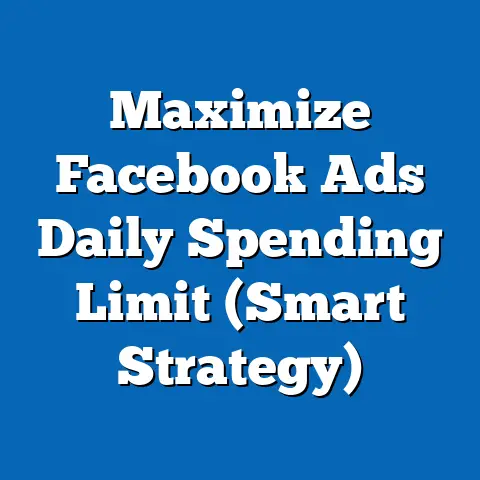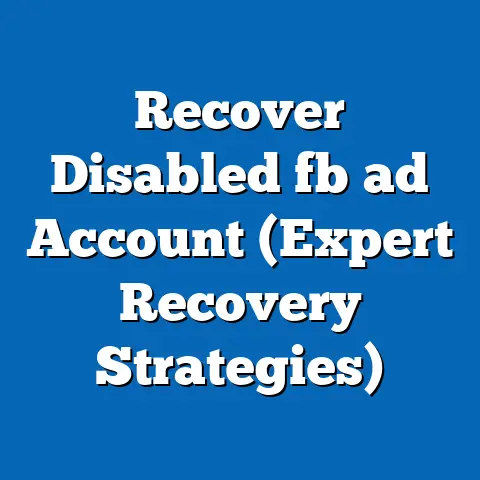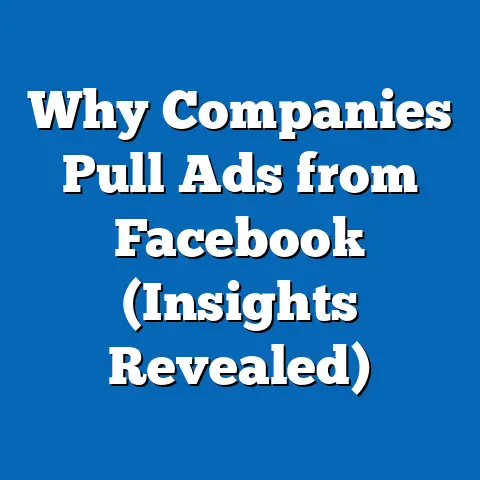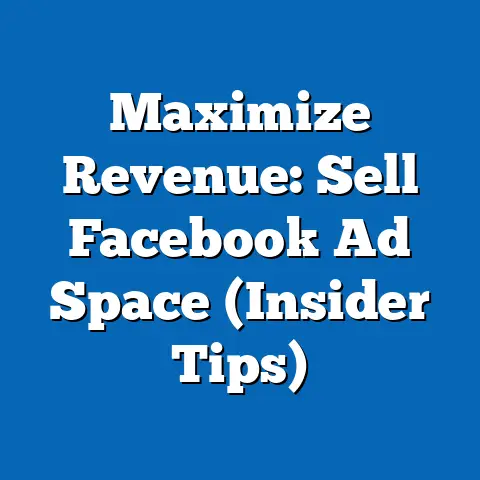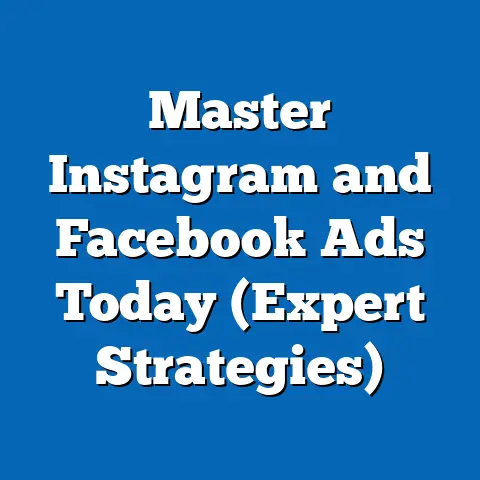Boost fb ad Effectiveness (Unlock Proven Strategies)
Did you know that businesses leveraging Facebook ads can achieve an average ROI of 152%? That’s not just a number; it’s a testament to the immense potential that lies within Facebook advertising. But here’s the catch: that ROI isn’t guaranteed. It’s earned through strategic planning, compelling creative, laser-focused targeting, and relentless optimization. I’ve seen firsthand how a well-executed Facebook ad campaign can transform a business, and conversely, how a poorly managed one can drain resources with little to show for it. That’s why I’m sharing these proven strategies to help you unlock the true power of Facebook ads and achieve the results you deserve.
Understanding the Facebook Ad Ecosystem
Facebook advertising is a powerful beast, but before you can tame it, you need to understand its habitat. It’s more than just slapping up an image and hoping for the best. It’s a complex ecosystem with a variety of ad formats, targeting options, and bidding strategies, all designed to connect businesses with the right audience.
A World of Ad Formats
The beauty of Facebook ads lies in its versatility. You’re not limited to just one type of ad; you have a whole arsenal at your disposal:
- Image Ads: These are the classic, straightforward ads featuring a single image and accompanying text. They’re great for simple product promotions or brand awareness campaigns.
- Video Ads: Video is king in the digital world, and Facebook is no exception. Video ads are highly engaging and perfect for showcasing your product in action or telling a compelling story.
- Carousel Ads: These ads allow you to display multiple images or videos in a swipeable format, ideal for showcasing a range of products or highlighting different features of a single product.
- Slideshow Ads: A lightweight alternative to video ads, slideshow ads combine multiple images into a short, engaging video-like experience.
- Collection Ads: Designed for e-commerce businesses, collection ads feature a hero image or video followed by a selection of relevant products, making it easy for users to browse and purchase directly from the ad.
- Instant Experience Ads: These immersive, full-screen ads load instantly and can include a mix of videos, images, carousels, and text, providing a rich and engaging experience for the user.
- Lead Ads: These ads are specifically designed to collect leads directly within Facebook, making it easy for users to sign up for your newsletter, request a demo, or download a free resource.
Each format has its strengths and weaknesses, and the best choice for you will depend on your specific goals and target audience. I’ve found that testing different formats is crucial to see what resonates best with your audience.
The Power of Facebook’s User Demographics and Targeting
Facebook’s real strength lies in its unparalleled targeting capabilities. With over 2.9 billion monthly active users, Facebook has a wealth of data on its users, allowing you to target your ads with incredible precision. You can target users based on:
- Demographics: Age, gender, location, education, job title, and more.
- Interests: Hobbies, passions, and interests based on the pages they like, the groups they join, and the content they engage with.
- Behaviors: Purchase history, travel habits, device usage, and other online behaviors.
- Connections: People who like your page, friends of people who like your page, or people who have interacted with your website or app.
- Custom Audiences: You can upload your own customer data (email addresses, phone numbers) to create custom audiences and target your ads to your existing customers or lookalike audiences (users who share similar characteristics to your existing customers).
The level of granularity you can achieve with Facebook targeting is truly remarkable. I once ran a campaign for a local bakery targeting users within a 5-mile radius who were interested in baking and had recently purchased baking supplies online. The results were phenomenal!
The Evolution of Facebook Advertising
Facebook advertising has evolved significantly since its inception. What started as simple banner ads has transformed into a sophisticated platform with advanced targeting options, AI-powered optimization, and a wide range of ad formats.
- Early Days: In the early days, Facebook advertising was relatively simple, with limited targeting options and basic ad formats.
- The Rise of News Feed Ads: The introduction of news feed ads revolutionized Facebook advertising, allowing businesses to reach users in a more engaging and native way.
- Advanced Targeting: Facebook gradually introduced more advanced targeting options, allowing businesses to target users based on demographics, interests, behaviors, and connections.
- AI-Powered Optimization: Facebook’s AI-powered optimization algorithms have become increasingly sophisticated, allowing businesses to automate their ad campaigns and optimize for specific goals.
- Privacy Changes: Recent changes in privacy regulations (like Apple’s iOS 14 update) have impacted Facebook advertising, making it more challenging to track user behavior and measure ad performance.
Despite these challenges, Facebook advertising remains a powerful and relevant tool for digital marketers. The key is to stay informed about the latest trends and best practices, adapt to changes in the platform, and continuously optimize your campaigns for maximum effectiveness.
Takeaway: Understand the diverse ad formats and powerful targeting options within the Facebook ecosystem to lay the groundwork for successful campaigns.
Setting Clear Objectives for Your Ads
Before you even think about creating an ad, you need to know why you’re advertising. What are you hoping to achieve? Are you trying to build brand awareness, generate leads, drive sales, or something else entirely? Setting clear, measurable objectives is the foundation of any successful Facebook ad campaign.
The Importance of Defining Clear, Measurable Objectives
Without clear objectives, you’re essentially throwing money at the wall and hoping something sticks. Defining your objectives gives you a clear roadmap for your campaign, helps you choose the right ad formats and targeting options, and allows you to measure your success accurately.
Here are some common objectives for Facebook ad campaigns:
- Brand Awareness: Increase awareness of your brand among your target audience.
- Reach: Maximize the number of people who see your ad.
- Traffic: Drive traffic to your website or landing page.
- Engagement: Increase engagement with your Facebook page or posts (likes, comments, shares).
- Lead Generation: Collect leads for your business (email addresses, phone numbers, etc.).
- App Installs: Drive installs of your mobile app.
- Video Views: Increase the number of views of your video.
- Conversions: Drive specific actions on your website, such as purchases, sign-ups, or form submissions.
- Catalog Sales: Promote products from your e-commerce catalog.
- Store Traffic: Drive foot traffic to your physical store.
It’s important to choose objectives that are specific, measurable, achievable, relevant, and time-bound (SMART). For example, instead of saying “I want to increase brand awareness,” you might say “I want to increase brand awareness among women aged 25-34 in the United States by 20% in the next three months.”
Aligning Objectives with Strategies and Ad Formats
Different objectives require different strategies and ad formats. For example, if your objective is brand awareness, you might focus on reach and frequency, using visually appealing image or video ads to capture attention. If your objective is lead generation, you might use lead ads with a compelling offer to encourage users to sign up.
Here’s a table summarizing which ad formats are best suited for different objectives:
| Objective | Recommended Ad Formats |
|---|---|
| Brand Awareness | Image ads, video ads, slideshow ads |
| Reach | Image ads, video ads |
| Traffic | Image ads, video ads, carousel ads |
| Engagement | Image ads, video ads, text posts |
| Lead Generation | Lead ads, instant experience ads |
| App Installs | Image ads, video ads |
| Video Views | Video ads |
| Conversions | Image ads, video ads, carousel ads, collection ads |
| Catalog Sales | Carousel ads, collection ads |
| Store Traffic | Image ads, video ads, local awareness ads |
| Objective | Recommended Ad Formats |
|---|---|
| Brand Awareness | Image ads, video ads, slideshow ads |
| Reach | Image ads, video ads |
| Traffic | Image ads, video ads, carousel ads |
| Engagement | Image ads, video ads, text posts |
| Lead Generation | Lead ads, instant experience ads |
| App Installs | Image ads, video ads |
| Video Views | Video ads |
| Conversions | Image ads, video ads, carousel ads, collection ads |
| Catalog Sales | Carousel ads, collection ads |
| Store Traffic | Image ads, video ads, local awareness ads |
I once worked with a client who was struggling to generate leads for their consulting business. They were running generic image ads with a vague call to action. After analyzing their target audience and their needs, we created a lead ad offering a free e-book on a topic that was highly relevant to their target audience. The results were dramatic, with lead generation increasing by over 300%.
Real-World Examples of Successful Objective Alignment
Numerous businesses have successfully aligned their ad objectives with their overall marketing goals.
- Dollar Shave Club: Dollar Shave Club used video ads to build brand awareness and drive subscriptions. Their humorous and irreverent videos went viral, helping them disrupt the shaving industry.
- Airbnb: Airbnb uses carousel ads to showcase unique properties around the world, driving traffic to their website and encouraging bookings.
- HubSpot: HubSpot uses lead ads to collect leads for their marketing automation software, offering free e-books, webinars, and other resources in exchange for contact information.
- Warby Parker: Warby Parker uses image ads to promote their stylish and affordable eyeglasses, driving traffic to their website and encouraging online purchases.
- Sephora: Sephora uses collection ads to showcase their beauty products, making it easy for users to browse and purchase directly from the ad.
These examples demonstrate the importance of aligning your ad objectives with your overall marketing goals and choosing the right ad formats and strategies to achieve those objectives.
Takeaway: Clearly define your advertising objectives before creating your ads. Align your objectives with the appropriate strategies and ad formats to maximize your chances of success.
Crafting Compelling Ad Content
Okay, you’ve got your objectives defined and you understand the Facebook ad landscape. Now comes the fun part: creating ad content that grabs attention, sparks interest, and compels action. This is where your creativity comes into play.
The Elements of Effective Ad Copy
Your ad copy is your chance to speak directly to your target audience. It needs to be clear, concise, and compelling. Here are some key elements to consider:
- Headline: Your headline is the first thing people will see, so it needs to be attention-grabbing and relevant to your target audience. Use strong verbs, numbers, and questions to pique interest.
- Description: Your description should provide more detail about your product or service and highlight its benefits. Focus on solving a problem or fulfilling a need.
- Call to Action (CTA): Your CTA tells people what you want them to do next. Use clear and concise language, such as “Learn More,” “Shop Now,” “Sign Up,” or “Get Started.”
I’ve found that using a strong value proposition in your ad copy is essential. What makes your product or service unique and valuable? Why should people choose you over your competitors? Communicate this clearly in your ad copy.
The Role of Visuals in Facebook Ads
Visuals are incredibly important in Facebook ads. People are visual creatures, and a compelling image or video can make all the difference in capturing their attention.
- High-Quality Images: Use high-resolution images that are visually appealing and relevant to your target audience. Avoid using stock photos that look generic and unauthentic.
- Engaging Videos: Video ads are highly engaging and perfect for showcasing your product in action or telling a compelling story. Keep your videos short and sweet (under 30 seconds) and make sure they’re visually appealing.
- Branding: Incorporate your branding into your visuals, including your logo, colors, and fonts. This will help people recognize your brand and build brand awareness.
- Relevance: Make sure your visuals are relevant to your ad copy and your target audience. Use visuals that resonate with their interests and needs.
I once worked with a client who was selling handmade jewelry. Their initial ads featured poorly lit, unappealing photos of their jewelry. After we invested in professional photography, the quality of their visuals improved dramatically, and their ad performance skyrocketed.
Tips for Writing Engaging Copy
Writing engaging copy that resonates with your target audience is an art form. Here are some tips to help you craft compelling ad copy:
- Know Your Audience: Understand your target audience’s needs, interests, and pain points. Use language that resonates with them and addresses their specific concerns.
- Tell a Story: People love stories. Use storytelling techniques to connect with your audience on an emotional level and make your ad more memorable.
- Use Emotional Triggers: Tap into your audience’s emotions by using words and phrases that evoke feelings of happiness, excitement, fear, or urgency.
- Focus on Benefits, Not Features: Instead of just listing the features of your product or service, focus on the benefits it provides. How will it make people’s lives easier, better, or more enjoyable?
- Use Social Proof: Include testimonials, reviews, or case studies to build trust and credibility.
- Create a Sense of Urgency: Use language that creates a sense of urgency, such as “Limited Time Offer,” “While Supplies Last,” or “Don’t Miss Out.”
- Keep it Concise: People have short attention spans, so keep your ad copy concise and to the point. Get to the point quickly and make it easy for people to understand your message.
- A/B Test: Experiment with different versions of your ad copy to see what resonates best with your target audience. Test different headlines, descriptions, and CTAs to optimize your ad performance.
Takeaway: Craft compelling ad content with clear, concise copy and visually appealing images or videos. Know your audience, tell a story, and focus on the benefits of your product or service.
Targeting the Right Audience
You can have the most amazing ad copy and stunning visuals, but if you’re showing it to the wrong people, it’s all for naught. Targeting the right audience is crucial for maximizing the effectiveness of your Facebook ads.
Facebook’s Advanced Targeting Options
As I mentioned earlier, Facebook offers a wide range of advanced targeting options, allowing you to target your ads with incredible precision.
- Demographic Targeting: Target users based on age, gender, location, education, job title, and more. This is a great way to narrow down your audience to people who are most likely to be interested in your product or service.
- Interest Targeting: Target users based on their interests, hobbies, and passions. This is a great way to reach people who are already interested in topics related to your product or service.
- Behavior Targeting: Target users based on their purchase history, travel habits, device usage, and other online behaviors. This is a great way to reach people who are likely to be interested in buying your product or service.
- Connection Targeting: Target people who like your page, friends of people who like your page, or people who have interacted with your website or app. This is a great way to reach people who are already familiar with your brand.
Audience Segmentation and Custom Audiences
To get even more targeted, you can segment your audience based on various criteria. This involves dividing your overall target audience into smaller, more homogenous groups based on shared characteristics. This allows you to tailor your ad copy and visuals to each segment, making your ads more relevant and engaging.
- Customer Data: Upload your own customer data (email addresses, phone numbers) to create custom audiences and target your ads to your existing customers.
- Website Visitors: Create custom audiences based on people who have visited your website or specific pages on your website.
- App Users: Create custom audiences based on people who have used your mobile app.
- Engagement: Create custom audiences based on people who have engaged with your Facebook page or ads (liked, commented, shared, watched a video, etc.).
Leveraging Facebook Pixel for Retargeting
The Facebook Pixel is a small piece of code that you install on your website. It allows you to track the actions that people take on your website after clicking on your Facebook ad. This data can be used to optimize your ad campaigns and retarget users who have previously interacted with your website.
Retargeting is a powerful strategy for reaching people who have already shown an interest in your product or service. For example, you can retarget people who have visited your website but haven’t made a purchase, showing them ads for the products they viewed.
I once ran a retargeting campaign for an e-commerce client that resulted in a 300% increase in sales. We targeted people who had added products to their cart but hadn’t completed the checkout process, offering them a discount to encourage them to complete their purchase.
Takeaway: Utilize Facebook’s advanced targeting options to reach the right audience with your ads. Segment your audience and create custom audiences based on your own data. Leverage the Facebook Pixel for retargeting campaigns.
Budgeting and Bidding Strategies
Setting a budget for your Facebook ad campaigns and choosing the right bidding strategy is crucial for maximizing your return on investment. You don’t want to overspend, but you also don’t want to underspend and miss out on potential opportunities.
Setting a Budget for Facebook Ad Campaigns
There are two main types of budgets you can set for your Facebook ad campaigns:
- Daily Budget: A daily budget is the average amount you’re willing to spend each day on your ad campaign. Facebook will try to spend this amount each day, but it may spend slightly more or less depending on the performance of your ads.
- Lifetime Budget: A lifetime budget is the total amount you’re willing to spend on your ad campaign over its entire duration. Facebook will try to spread your budget evenly over the duration of your campaign.
The best choice for you will depend on your specific goals and needs. If you want to run your ads continuously, a daily budget is a good choice. If you want to run your ads for a specific period of time, a lifetime budget is a better choice.
Understanding Bidding Strategies
Facebook offers a variety of bidding strategies, each designed to help you achieve your specific objectives.
- Cost Per Click (CPC): You pay each time someone clicks on your ad. This is a good choice if your objective is to drive traffic to your website.
- Cost Per Impression (CPM): You pay each time your ad is shown to someone. This is a good choice if your objective is to build brand awareness.
- Cost Per Action (CPA): You pay each time someone takes a specific action after seeing your ad, such as making a purchase or signing up for a newsletter. This is a good choice if your objective is to drive conversions.
- Lowest Cost: Facebook will automatically bid for you, trying to get you the lowest possible cost per result. This is a good choice if you’re new to Facebook advertising and don’t know how to set your bids manually.
- Target Cost: You set a target cost for each result, and Facebook will try to achieve that cost. This is a good choice if you have a specific cost per result in mind.
- Bid Cap: You set a maximum bid that you’re willing to pay for each result. This is a good choice if you want to control your costs and prevent overspending.
The best bidding strategy for you will depend on your specific objectives and your budget. It’s important to experiment with different bidding strategies to see what works best for you.
A/B Testing and Optimizing Ad Spend
A/B testing is a crucial part of optimizing your ad spend. It involves creating two or more versions of your ad and testing them against each other to see which one performs best.
You can A/B test different elements of your ad, such as your headline, description, visuals, or call to action. By testing different versions of your ad, you can identify the elements that are most effective and optimize your ad performance.
I once ran an A/B test for a client that resulted in a 50% increase in click-through rate. We tested two different headlines, and one headline significantly outperformed the other.
Takeaway: Set a budget that aligns with your goals and choose a bidding strategy that maximizes your return on investment. Continuously A/B test your ads and optimize your ad spend based on performance data.
Analyzing and Optimizing Ad Performance
Running Facebook ads isn’t a “set it and forget it” kind of deal. You need to constantly monitor your ad performance and make adjustments to optimize your results.
Key Performance Indicators (KPIs) to Track
There are several key performance indicators (KPIs) that you should track when evaluating your ad performance:
- Click-Through Rate (CTR): The percentage of people who click on your ad after seeing it. A high CTR indicates that your ad is relevant and engaging to your target audience.
- Conversion Rate: The percentage of people who take a specific action after clicking on your ad, such as making a purchase or signing up for a newsletter. A high conversion rate indicates that your ad is effectively driving conversions.
- Cost Per Click (CPC): The amount you pay each time someone clicks on your ad. A low CPC indicates that your ad is cost-effective.
- Cost Per Conversion (CPA): The amount you pay each time someone takes a specific action after clicking on your ad. A low CPA indicates that your ad is effectively driving conversions at a reasonable cost.
- Return on Ad Spend (ROAS): The amount of revenue you generate for every dollar you spend on advertising. A high ROAS indicates that your ad campaign is profitable.
- Frequency: The average number of times that each person sees your ad. A high frequency can lead to ad fatigue, so it’s important to monitor your frequency and adjust your targeting or ad creative if necessary.
- Relevance Score: Facebook’s assessment of how relevant your ad is to your target audience. A high relevance score indicates that your ad is well-targeted and engaging.
Using Facebook Ads Manager for In-Depth Analysis
Facebook Ads Manager is a powerful tool for analyzing your ad performance. It provides detailed data on your ad impressions, clicks, conversions, and other KPIs. You can use Facebook Ads Manager to:
- Track Your KPIs: Monitor your key performance indicators over time to see how your ad performance is trending.
- Segment Your Data: Segment your data by demographics, interests, behaviors, and other criteria to identify which segments are performing best.
- Compare Ad Performance: Compare the performance of different ads, ad sets, and campaigns to identify what’s working and what’s not.
- Create Custom Reports: Create custom reports to track the metrics that are most important to you.
Actionable Steps for Optimizing Ad Campaigns
Based on your performance data, you can take several actionable steps to optimize your ad campaigns:
Staying Updated with Facebook Advertising Trends
The world of Facebook advertising is constantly evolving. New features, algorithms, and best practices are introduced regularly. To stay ahead of the curve and maximize the effectiveness of your campaigns, it’s crucial to stay updated with the latest trends and updates.
Resources for Staying Informed
Here are some resources for staying informed about Facebook advertising trends:
- Facebook’s Business Blog: Facebook’s official blog provides updates on new features, best practices, and case studies.
- Industry Publications: Follow leading digital marketing publications, such as Marketing Land, Search Engine Land, and Social Media Examiner, to stay informed about industry trends.
- Online Marketing Forums: Participate in online marketing forums and communities to connect with other marketers and share insights.
- Facebook Advertising Conferences: Attend Facebook advertising conferences and events to learn from industry experts and network with other marketers.
- Facebook Blueprint: Facebook Blueprint offers a range of online courses and certifications on Facebook advertising.
Recent Trends Impacting Facebook Ad Strategies
Several recent trends have impacted Facebook ad strategies:
- The Rise of Video Content: Video is becoming increasingly popular on Facebook, and video ads are highly engaging.
- Increased Focus on Privacy and Data Protection: Recent changes in privacy regulations (like Apple’s iOS 14 update) have made it more challenging to track user behavior and measure ad performance.
- AI-Powered Automation: Facebook’s AI-powered automation tools are becoming increasingly sophisticated, allowing businesses to automate their ad campaigns and optimize for specific goals.
- The Metaverse: Facebook’s investment in the metaverse is likely to have a significant impact on advertising in the future.
Takeaway: Stay updated with the latest trends and updates in Facebook advertising. Follow industry publications, participate in online communities, and attend industry events.
Conclusion
Facebook advertising offers incredible potential for businesses of all sizes. By understanding the Facebook ad ecosystem, setting clear objectives, crafting compelling ad content, targeting the right audience, optimizing your budget and bidding strategies, analyzing your ad performance, and staying updated with the latest trends, you can unlock the true power of Facebook ads and achieve the results you deserve.
Don’t be afraid to experiment with different strategies and tactics to see what works best for your business. The key is to be data-driven, adaptable, and persistent. With the right approach, you can transform your Facebook ads from a cost center into a profit center and achieve your business goals. So, go ahead, take action, and start experimenting with the strategies outlined in this guide. Your Facebook ad success story awaits!

